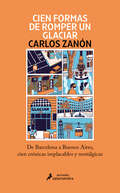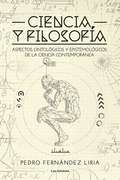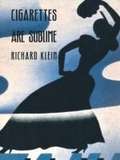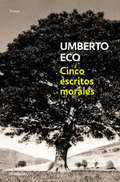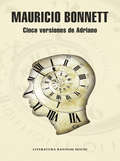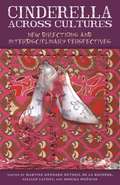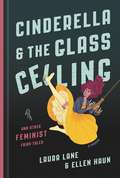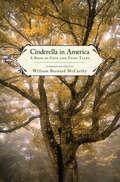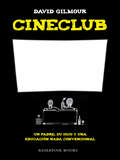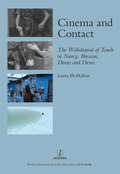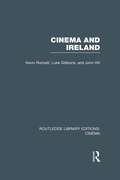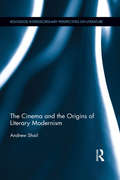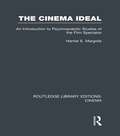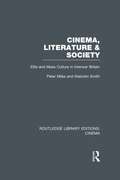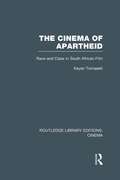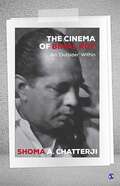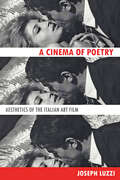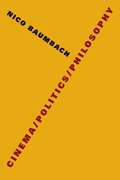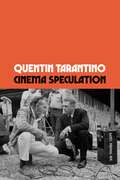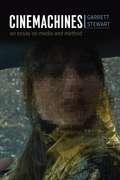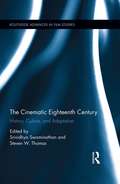- Table View
- List View
Cien formas de romper un glaciar: De Barcelona a Buenos Aires, cien crónicas implacables y nostálgicas
by Carlos ZanónCien crónicas escogidas en las que Carlos Zanón nos desvela una realidad íntima e inaudita a través de su mirada cáustica y lírica Taxistas, bares, barrios y ciudades, mitos de la infancia, libros, películas, mucha música y familia: así de extenso es el «universo Zanón», y así de variadas son su flora y su insólita fauna, fruto de una reflexión implacable, pero también un tanto melancólica, sobre la realidad y las cosas del día a día que ve, piensa y recrea a su manera.Novelista y poeta, Carlos Zanón es también un narrador que escribe en un periódico. Tras varios años de colaboraciones ininterrumpidas en prensa, nos ofrece en Cien formas de romper un glaciar la contraparte real del universo imaginario que palpita en todas sus novelas. Elogios sobre el autor:«Carlos Zanón ha desarrollado una forma de contar historias y crear personajes que lo distinguen entre muchos otros autores. El ritmo de su prosa cuidada late en cada oración, golpea, sacude.»Claudia Piñeiro «Que Carlos Zanón es una de las mejores cosas que le ha pasado a la literatura de estos lares en los últimos años, es algo que ya dejó de ser un secreto.»Carlos Prieto«Carlos Zanón es poeta. Me gusta decirlo […] para responder a quienes defienden una novela sin poesía, una narración documentada y ceñida a los hechos, periodística supongo... No sé bien qué defienden.»Lilian Neuman «El cronista despiadado de nuestros tiempos.»Rosa Mora
Ciencia y Filosofía: Aspectos ontológicos y epistemológicos de la ciencia contemporánea
by Pedro Fernández LiriaLa ciencia contemporánea revoluciona el pensamiento humano. Ciencia y Filosofía nos propone un viaje fascinante por las sorprendentes implicaciones filosóficas de la ciencia contemporánea. <P><P>La última gran revolución en las ciencias físicas ha situado al pensamiento humano ante el reto más grande que jamás se le ha presentado, y el autor del presente libro se esmera en proporcionar al lector las claves necesarias para comprender su alcance y para poder afrontarlo. <P><P>Ciencia y Filosofía es un concienzudo y documentado estudio capaz de cautivar tanto a filósofos y científicos, como a cualquiera que, sin una especial formación técnica y matemática, se halle interesado por los últimos progresos teóricos de la ciencia y por las conclusiones filosóficas de la revolución científica que provocaron las dos grandes teorías físicas del siglo XX: la teoría de la relatividad y la mecánica cuántica. <P><P>Además de exponer el carácter esencial de ambas teorías, el libro discute algunas de las interpretaciones que se han hecho de las mismas y repasa algunos de los debates y controversias que su aparición ha suscitado en los últimos cien años (tanto entre los propios científicos, como entre los filósofos). <P>Por lo demás, Ciencia y Filosofía es un libro que podría y nos atreveríamos a decir que debería interesar a cualquiera que sienta una pasión por la ciencia como la que el propio autor trata de contagiar desde la primera página.
Cigarettes Are Sublime
by Richard KleinCigarettes are bad for you; that is why they are so good. With its origins in the author's urgent desire to stop smoking, Cigarettes Are Sublime offers a provocative look at the literary, philosophical, and cultural history of smoking. Richard Klein focuses on the dark beauty, negative pleasures, and exacting benefits attached to tobacco use and to cigarettes in particular. His appreciation of paradox and playful use of hyperbole lead the way on this aptly ambivalent romp through the cigarette in war, movies (the "Humphrey Bogart cigarette"), literature, poetry, and the reflections of Sartre to show that cigarettes are a mixed blessing, precisely sublime.
Cinco escritos morales
by Umberto EcoUmberto Eco reflexiona sobre la moral y la ética a través de una mirada crítica sobre nuestra historia reciente. Umberto Eco analiza con mirada lúcida y gran brillantez cinco temas de actualidad e importancia extremas: por qué la guerra ha pasado a ser hoy día inviable, las características y vigencia del fascismo, los cambios de la prensa ante la presencia de la televisión, los fundamentos y la posibilidad de una ética laica, así como la tolerancia e intolerancia ante la migración que hará de Europa en los próximos años un continente multirracial. La crítica opina...«Muy convincente y con la clase de destellos de inteligencia y conocimiento que los lectores esperan de una de las mentes más brillantes de Italia.»Library Journal
Cinco novelas en clave simbólica
by Víctor García de la ConchaTodas las claves para disfrutar de la mejor literatura La creación de un espacio subjetivo, que trasciende el plano geográfico para instalarse en el del símbolo, es una de las conquistas de la novela moderna. Víctor García de la Concha explora en este estudio el espacio simbólico en cinco novelas magistrales del siglo XX: La casa verde, de Mario Vargas Llosa; Cien años de soledad, de Gabriel García Márquez; Madera de boj, de Camilo José Cela; Volverás a Región, de Juan Benet, y Sefarad, de Antonio Muñoz Molina. Cinco novelas en las que la palabra de sus creadores conforma lugares construidos a base de metáforas que adquieren su dimensión definitiva en la imaginación del lector, cuando se mueve por ellos y los interpreta. En palabras del autor, «lejos de ser un mero recipiente, el espacio se convierte en un molde activo y fecundo de significado. Sustenta y expresa ideas, sensaciones y sentimientos; dialoga intertextualmente con otros espacios de categoría análoga, y, maridado con el tiempo, se eleva por encima de la cronología particular del relato del que forma parte y proyecta al lector al espacio de los universales: de la anécdota a la categoría».
Cinco versiones de Adriano
by Mauricio BonnettUn día de verano Sebastián, un escritor colombiano, ve a través de laventana de su apartamento londinense a un hombre que le recuerda demanera inquietante a Adriano, un amigo suyo desaparecido en misteriosascircunstancias veinte años atrás. Cuando a los pocos días lo ve denuevo, el interés inicial se convierte en obsesión, y emprende entoncesuna suerte de persecución detectivesca para sacudirse la duda yrecuperar la tranquilidad. Pero la cacería de Sebastián se vuelve, a lapar, retrospectiva, pues busca a Adriano no solo en las calles deLondres sino en su remoto pasado, decidido a entender de una vez portodas, y con la ayuda de dos de sus viejos amigos, quién fue eseenigmático fragmento de su juventud y por qué nunca se supo nada más deél, como si se hubiera evaporado. De esta manera surge el retrato de unser complejo, contradictorio, casi indescifrable, así como un mosaico delos miedos, las dudas, los prejuicios, los remordimientos y losentusiasmos de toda una generación. Escrita con una prosa hipnótica,aguda y llena de hallazgos, e inclasificable por lo que tiene de novelade aprendizaje, de novela de misterio, de novela de aventuras, dereflexión poderosa sobre la soledad, la memoria y el paso del tiempo,Cinco versiones de Adriano confirma a Mauricio Bonnett como uno de losnarradores colombianos más notables de la actualidad.
Cinderella across Cultures: New Directions and Interdisciplinary Perspectives (Series in Fairy-Tale Studies)
by Martine Hennard Dutheil de la Rochère Gillian Lathey Monika WozniakThe Cinderella story is retold continuously in literature, illustration, music, theatre, ballet, opera, film, and other media, and folklorists have recognized hundreds of distinct forms of Cinderella plots worldwide. The focus of this volume, however, is neither Cinderella as an item of folklore nor its alleged universal meaning. In Cinderella across Cultures, editors Martine Hennard Dutheil de la Rochère, Gillian Lathey, and Monika Wozniak analyze the Cinderella tale as a fascinating, multilayered, and ever-changing story constantly reinvented in different media and traditions. The collection highlights the tale’s reception and adaptation in cultural and national contexts across the globe, including those of Italy, France, Germany, Britain, the Netherlands, Poland, and Russia. Contributors shed new light on classic versions of Cinderella by examining the material contexts that shaped them (such as the development of glass artifacts and print techniques), or by analyzing their reception in popular culture (through cheap print and mass media). The first section, “Contextualizing Cinderella,” investigates the historical and cultural contexts of literary versions of the tale and their diachronic transformations. The second section, “Regendering Cinderella,” tackles innovative and daring literary rewritings of the tale in the twentieth and twenty-first centuries, in particular modern feminist and queer takes on the classic plot. Finally, the third section, “Visualising Cinderella,” concerns symbolic transformations of the tale, especially the interaction between text and image and the renewal of the tale’s iconographic tradition. The volume offers an invaluable contribution to the study of this particular tale and also to fairy-tale studies overall. Readers interested in the visual arts, in translation studies, or in popular culture, as well as a wider audience wishing to discover the tale anew will delight in this collection.
Cinderella and the Glass Ceiling: And Other Feminist Fairy Tales
by Laura Lane Ellen Haunp.p1 {margin: 0.0px 0.0px 0.0px 0.0px; font: 13.3px Times} This wickedly wise (and wisecracking) parody of classic fairy tales redefines happily ever after for the modern feminist era.You know what? It's super creepy to kiss a woman who is unconscious. And you know what else? The way out of poverty isn't by marrying a rich dude -- or by wearing fragile footwear, for that matter. And while we're at it, why is the only woman who lives with seven men expected to do the cooking, cleaning, and laundry?Fairytales need a reboot, and comedy queens Laura Lane and Ellen Haun are the women to do it. In Cinderella and the Glass Ceiling, they offer a rollicking parody of classic (read: patriarchal) tales that turns sweet, submissive princesses into women who are perfectly capable of being the heroes of their own stories. Mulan climbs the ranks in the army but wages a different war when she finds out she's getting paid less than her fellow male captains, Wendy learns never to trust a man-boy stalking her window, Sleeping Beauty's prince gets a lesson in consent, and more.Busting with laugh-out-loud, razor-sharp twists to these outdated tales, Cinderella and the Glass Ceiling is fun, magical, necessary, and totally woke.
Cinderella in America: A Book of Folk and Fairy Tales
by William Bernard MccarthyFor years, many folklorists have denied the possibility of a truly American folk or fairy tale. They have argued that the tales found in the United States are watered-down derivatives of European fare. With this gathering, William Bernard McCarthy compiles evidence strongly to the contrary. Cinderella in America: A Book of Folk and Fairy Tales represents these tales as they have been told in the United States from Revolutionary days until the present. To capture this richness, tales are grouped in chapters that represent regional and ethnic groups, including Iberian, French, German, British, Irish, other European, African American, and Native American. These tales are drawn from published collections, journals, and archives, and from fieldwork by McCarthy and his colleagues. Created along the nationalist model of the Brothers Grimm yet as diverse in its voices and themes as the nation it represents, Cinderella in America shows these tales truly merit the designation American.
Cinderella Stories (Great Minds Wit & Wisdom #Grade 1, Module 4)
by Great MindsNIMAC-sourced textbook
Cindy's Cellar
by Sydnie Meltser Kleinhenz Colin ThompsonCindy finds a special door that leads her to the robot palace.
Cineclub
by David GilmourFue un trato muy poco convencional: Jesse podía dejar de ir al instituto, dormir todo el día, no trabajar, no pagar alquiler pero a cambio tenía que mantenerse alejado de las drogas y ver tres películas a la semana con su padre, el crítico de cine canadiense David Gilmour. Jesse aceptó de inmediato y al día siguiente padre e hijo comenzaron con la primera película de la lista: Los cuatrocientos golpes de François Truffaut. A lo largo de tres años padre e hijo vieron todo tipo de películas, desde las consideradas joyas del cine hasta los grandes bodrios de todos los tiempos. Con el trasfondo de El padrino, Instinto básico, Showgirls, Ciudadano Kane o La ley del silencio, David y Jesse hablan de los principales directores de cine, de las escenas célebres y de los actores que las protagonizaron, y poco a poco sobre todo tipo de temas: chicas, música, mal de amores, trabajo, drogas, talento, dinero, amor, amistad... Cineclub es un repaso personal de la historia del cine, un desafío a nuestras nociones de la educación y, sobre todo, la historia real y conmovedora acerca de cómo un padre y un hijo sortearon una época muy especial en su relación; en la que los hijos se encierran en sí mismos y los padres pierden la oportunidad de llegar a ellos. Esta es la historia de una decisión que lo cambió todo.
Cinema and Contact: The Withdrawal of Touch in Nancy, Bresson, Duras and Denis
by Laura McMahonDrawing on the work of contemporary French philosopher Jean-Luc Nancy, Cinema and Contact investigates the aesthe-tics and politics of touch in the cinema of three of the most prominent and distinctive filmmakers to have emerged in France during the last fifty years: Robert Bresson, Marguerite Duras and Claire Denis. Countering the domi-nant critical account of touch elaborated by recent models of embodied spectatorship, this book argues that cinema offers a privileged space for understanding touch in terms of spacing and withdrawal rather than immediacy and continuity. Such a deconstructive configuration of touch is shown here to have far-reaching implications, inviting an innovative rethinking of politics, aesthetics and theology via the textures of cinema. The first study to bring the thought of Nancy into sustained dialogue with a series of detailed analyses of films, Cinema and Contact also forges new interpretative perspectives on Bresson, Duras and Denis, tracing a compelling two-way exchange between cinema and philosophy.
Cinema and Ireland: Film, Culture And Politics (Routledge Library Editions: Cinema)
by Kevin Rockett Luke Gibbons John HillThis was the first comprehensive study of film production in Ireland from the silent period to the present day, and of representations of Ireland and ‘Irishness’ in native, British, and American films. It remains an authority on the topic. The book focuses on Irish history and politics to examine the context and significance of such films as Irish Destiny, The Quiet Man, Ryan’s Daughter, Man of Aran, Cal, The Courier, and The Dead.
Cinema and the Imagination in Katherine Mansfield’s Writing
by Teresa A. FisherUsing silent cinema as a critical lens enables us to reassess Katherine Mansfield's entire literary career. Starting from the awareness that innovation in literature is often the outcome of hybridisation, this book discusses not only a single case study, but also the intermedia exchanges in which literary modernism at large is rooted.
The Cinema and the Origins of Literary Modernism (Routledge Interdisciplinary Perspectives on Literature)
by Andrew ShailModernist writing has always been linked with cinema. The recent renaissance in early British film studies has allowed cinema to emerge as a major historical context for literary practice. Treating cinema as a historical rather than an aesthetic influence, this book analyzes the role of early British film culture in literature, thus providing the first account of cinema as a cause for modernism. Shail’s study draws on little-known sources to create a detailed picture of cinema following its ‘second birth’ as both institution and medium. The book presents a comprehensive account of how UK-based modernism originated as a consequence of—rather than a conscious aesthetic response to—this new component of the cultural landscape. Film’s new accounts of language, endeavor, time, collectivity and political change are first considered, then related to the patterns that comprised modernist texts. Authors discussed include Ford Madox Ford, Joseph Conrad, Wyndham Lewis, Ezra Pound, H.D., James Joyce, Virginia Woolf and Dorothy Richardson.
The Cinema Ideal: An Introduction to Psychoanalytic Studies of the Film Spectator (Routledge Library Editions: Cinema)
by Harriet E. MargolisThis study explores the model derived from Freudian and Lacanian psychoanalysis, via Marxism and semiotics, of looking at film. It retraces the steps of film theory from ideological criticism of the late ‘60s to spectator studies in 1988 when the book was originally published. Psychoanalysis enables a discussion of the cinema’s role as a social and political force and this book enters a discourse of the politics of representation. Reconstructing discussion of basic issues, the book addresses our instincts and defences in reacting to cinema, the similarity between mental processes and cinematic technique, narrative techniques and the ‘cinematic apparatus’. Importantly, the book concerns itself with the concept of ideology and how the filmviewing experience engages the spectator in a complex net of stimuli presenting representations of an ideal world and the effect of this within film studies.
Cinema, Literature & Society: Elite and Mass Culture in Interwar Britain (Routledge Library Editions: Cinema)
by Malcolm Smith Peter MilesDuring the interwar period cinema and literature seemed to be at odds with each other, part of the continuing struggle between mass and elite culture which so worried writers such as Aldous Huxley, T.S. Eliot and the Leavises. And this cultural divide appeared to be sharp evidence of a deeper struggle for control of the nation’s consciousness, not only between dominant and oppositional elements within Britain, but between British and American vales as well. On the one hand, films like Sing As We Go, Proud Valley, and The Stars Look Down consolidated the assumptions about the existence of a national rather than separate class identities. On the other hand, working-class literature such as Love on the Dole articulated working-class experience in a manner intended to bridge the gap between the ‘Two Englands’. This book, originally published in 1987, examines how two of the most significant cultural forms in Britain contributed indirectly to the stability of Britain in the interwar crisis, helping to construct a new class alliance. A major element in the investigation is an analysis of the mechanics of the development of a national cultural identity, alongside separate working-class culture, the development of the lower-middle class and the implications of the intrusion of Hollywood culture. The treatment throughout is thematic rather than text-oriented – works of Graham Greene, George Orwell, Bert Coombes, Evelyn Waugh, the British Documentary Film Movement and Michael Balcon are included in the wide range of material covered.
The Cinema of Apartheid: Race and Class in South African Film (Routledge Library Editions: Cinema)
by Keyan TomaselliThis study analyses the historical development of South African cinema up to he book's original publication in 1988. It describes the films and comments on their relationship to South African realities, addressing all aspects of the industry, focusing on domestic production, but also discussing international film companies who use South Africa as a location. It explores tensions between English-language and Afrikaans-language films, and between films made for blacks and films made for whites. Going behind the scenes the author looks at the financial infrastructure, the marketing strategies, and the works habits of the film industry. He concludes with a discussion of independent filmmaking, the obstacles facing South Africans who want to make films with artistic and political integrity, and the possibilities of progress in the future. Includes comprehensive bibliography and filmography listing all feature films made in South Africa between 1910 and 1985 together with documentary films by South Africans, non-South Africans, and exiles about the country.
The Cinema of Bimal Roy: An ′Outsider′ Within
by Shoma A. ChatterjiAn analysis of Bimal Roy’s films and their depiction of people outside the ‘mainstream’ The Cinema of Bimal Roy: An ‘Outsider’ Within examines Roy’s adaptations of Bengali and Hindi literary classics while dwelling on his approach and treatment of women, a focal point of many of his films. It draws attention to his cinema of social relevance—untouchability (Sujata), woman deserted by society and family (Biraj Bou), child marriage (Parineeta) and the inhumanity of oppression and forced urbanization (Do Bigha Zameen). The book goes on to discuss Roy’s ability to bestow new screen identities to established actors such as Nutan, Meena Kumari and Dilip Kumar on one hand and discover new talents such as Sunil Dutt, Sadhana and Tarun Bose on the other. Apart from this, his tutelage introduced many new faces to the film industry—Salil Choudhury, Hrishikesh Mukherjee, Nabendu Ghosh and Gulzar among others. Further, the book details the aesthetics of technique—cinematography, editing and sound—in Roy’s films; his movies had some of the best musical scores in Hindi cinema. It also analyses what made Madhumati his biggest commercial success.
A Cinema of Poetry: Aesthetics of the Italian Art Film
by Joseph LuzziExplores the poetics and aesthetics of the Italian art film in Rossellini, Antonioni, Fellini, and other groundbreaking directors.A Cinema of Poetry brings Italian film studies into dialogue with fields outside its usual purview by showing how films can contribute to our understanding of aesthetic questions that stretch back to Homer. Joseph Luzzi considers the relation between film and literature, especially the cinematic adaptation of literary sources and, more generally, the fields of rhetoric, media studies, and modern Italian culture.The book balances theoretical inquiry with close readings of films by the masters of Italian cinema: Roberto Rossellini, Vittorio De Sica, Luchino Visconti, Michelangelo Antonioni, Federico Fellini, Pier Paolo Pasolini, Bernardo Bertolucci, and others. Luzzi's study is the first to show how Italian filmmakers address such crucial aesthetic issues as the nature of the chorus, the relation between symbol and allegory, the literary prehistory of montage, and the place of poetry in cinematic expression—what Pasolini called the "cinema of poetry." While Luzzi establishes how certain qualities of film—its link with technological processes, capacity for mass distribution, synthetic virtues (and vices) as the so-called total art—have reshaped centuries-long debates, A Cinema of Poetry also explores what is specific to the Italian art film and, more broadly, Italian cinematic history. In other words, what makes this version of the art film recognizably "Italian"?
Cinema/Politics/Philosophy (Film and Culture Series)
by Nico BaumbachAlmost fifty years ago, Jean-Louis Comolli and Jean Narboni published the manifesto “Cinema/Ideology/Criticism,” helping to set the agenda for a generation of film theory that used cinema as a means of critiquing capitalist ideology. In recent decades, film studies has moved away from politicized theory, abandoning the productive ways in which theory understands the relationship between cinema, politics, and art. In Cinema/Politics/Philosophy, Nico Baumbach revisits the much-maligned tradition of seventies film theory to reconsider: What does it mean to call cinema political?In this concise and provocative book, Baumbach argues that we need a new philosophical approach that sees cinema as both a mode of thought and a form of politics. Through close readings of the writings on cinema by the contemporary continental philosophers Jacques Rancière, Alain Badiou, and Giorgio Agamben, he asks us to rethink both the legacy of ideology critique and Deleuzian film-philosophy. He explores how cinema can condition philosophy through its own means, challenging received ideas about what is seeable, sayable, and doable. Cinema/Politics/Philosophy offers fundamental new ways to think about cinema as thought, art, and politics.
Cinema Speculation
by Quentin TarantinoA unique cocktail of personal memoir, cultural criticism and Hollywood history by the one and only Quentin Tarantino.The long-awaited first work of nonfiction from the author of the number one New York Times bestselling Once Upon a Time in Hollywood: a deliriously entertaining, wickedly intelligent cinema book as unique and creative as anything by Quentin Tarantino.In addition to being among the most celebrated of contemporary filmmakers, Quentin Tarantino is possibly the most joyously infectious movie lover alive. For years he has touted in interviews his eventual turn to writing books about films. Now, with CINEMA SPECULATION, the time has come, and the results are everything his passionate fans - and all movie lovers - could have hoped for. Organized around key American films from the 1970s, all of which he first saw as a young moviegoer at the time, this book is as intellectually rigorous and insightful as it is rollicking and entertaining. At once film criticism, film theory, a feat of reporting, and wonderful personal history, it is all written in the singular voice recognizable immediately as QT's and with the rare perspective about cinema possible only from one of the greatest practitioners of the artform ever.
Cinemachines: An Essay on Media and Method
by Garrett StewartThe hero stands on stage in high-definition 3-D while doubled on a crude pixel screen in Billy Lynn’s Long Halftime Walk. Alien ships leave Earth by dissolving at the conclusion of Arrival. An illusory death spiral in Vertigo transitions abruptly to a studio set, jolting the spectator. These are a few of the startling visual moments that Garrett Stewart examines in Cinemachines, a compelling, powerful, and witty book about the cultural and mechanical apparatuses that underlie modern cinema. Engaging in fresh ways with revelatory special effects in the history of cinematic storytelling—from Buster Keaton’s breaching of the film screen in Sherlock Jr. to the pixel disintegration of a remotely projected hologram in Blade Runner 2049—Stewart’s book puts unprecedented emphasis on technique in moving image narrative. Complicating and revising the discourse on historical screen processes, Cinemachines will be crucial reading for anyone interested in the evolution of the movies from a celluloid to a digital medium.
The Cinematic Eighteenth Century: History, Culture, and Adaptation (Routledge Advances in Film Studies)
by Srividhya Swaminathan Steven W. ThomasThis collection explores how film and television depict the complex and diverse milieu of the eighteenth century as a literary, historical, and cultural space. Topics range from adaptations of Austen’s Sense and Sensibility and Defoe's Robinson Crusoe (The Martian) to historical fiction on the subjects of slavery (Belle), piracy (Crossbones and Black Sails), monarchy (The Madness of King George and The Libertine), print culture (Blackadder and National Treasure), and the role of women (Marie Antoinette, The Duchess, and Outlander). This interdisciplinary collection draws from film theory and literary theory to discuss how film and television allows for critical re-visioning as well as revising of the cultural concepts in literary and extra-literary writing about the historical period.
